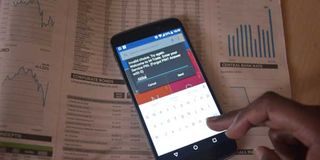Lack of crucial information will kill M-Akiba trading

After the initial technical hitch, the secondary market trading of the M-Akiba bond started last week. Unfortunately, there is very little information about it. It was easy: you dial *889# from a Safaricom or Airtel line and then follow the simple instructions that come on your screen. PHOTO | SALATON NJAU
What you need to know:
- The answer to the second question would have been clear if the system had given me a summary of my order – showing how much it would cost me. But it didn’t!
- After 15 minutes waiting, I decided to crunch some numbers. The M-Akiba bond started earning interest on 10th April. So, in the nine days had elapsed by the 19th, the 10 per cent per year had accumulated to 0.2473p.c.
After the initial technical hitch, the secondary market trading of the M-Akiba bond started last week.
Unfortunately, there is very little information about it. On the day I wrote this article (Wednesday, April 19), I tried to participate in that market. It was easy: you dial *889# from a Safaricom or Airtel line and then follow the simple instructions that come on your screen.
I found that the price of the day was Sh1.0030 per bond shilling. I was not allowed to negotiate at all: the system just asked me to enter the amount of money I wished to invest. I placed an order for a Sh3,000 bond and waited and waited…for a reply confirming the trade…
As I waited, two questions lingered in my mind. First: how was the price arrived at? Second: is this a clean or dirty price?
The answer to the second question would have been clear if the system had given me a summary of my order – showing how much it would cost me. But it didn’t!
After 15 minutes waiting, I decided to crunch some numbers. The M-Akiba bond started earning interest on 10th April. So, in the nine days had elapsed by the 19th, the 10 per cent per year had accumulated to 0.2473p.c.
NEW CALCULATION
Thus a Sh3,000 bond had earned 3,000x0.2473/100 = Sh7.42 in interest by that day. In other words, the investment was now worth Sh3,007.42.
Assuming that the quoted price of Sh1.0030 was dirty, the market cost of a Sh3,000 bond is Sh3,009.00. Would it be better to sell?
After all, it is Sh1.48 higher than the intrinsic value. Well; let’s not forget that there is a trading commission to be paid by both the seller and the buyer.
The rate is 0.535 per cent of the bond’s face value, that is, Sh16.05. Therefore, the seller will take home Sh3,009 – Sh16.05 = Sh2,992.95 and I should expect to pay Sh3,009 + Sh16.05 = Sh3025.05.
I have no problem with this deal since, come October 2017, I will get my Sh150 payment – the interest for the full six-month period! The seller, however, walks away Sh7 poorer than he was when he bought the bond!
If the quoted price was the clean one, then I expect to pay Sh3,009 for the bond, plus Sh7.42 accrued interest, plus Sh16.05 commission. Altogether, my bill comes to Sh3,032.47. The seller will get Sh3,009 + Sh7.42 – Sh16.05 = Sh3,000.37.
Looking at this new calculation, I am convinced that the Sh1.0030 quote was a clean price. Otherwise, it wouldn’t make any sense for the seller. Still, I have no problem with it for I will get Sh150 in October and every six months thereafter until April 2020.
All in all, I am afraid that the M-Akiba bond might not go very far because crucial information is not readily available.
***PS: just got a message that my mobile money wallet was deducted Sh2,999.96 for the M-Akiba. I was allocated a bond worth Sh2,981. The system say that it is processing a refund since the “order is not valid”. I don’t know what went wrong!




